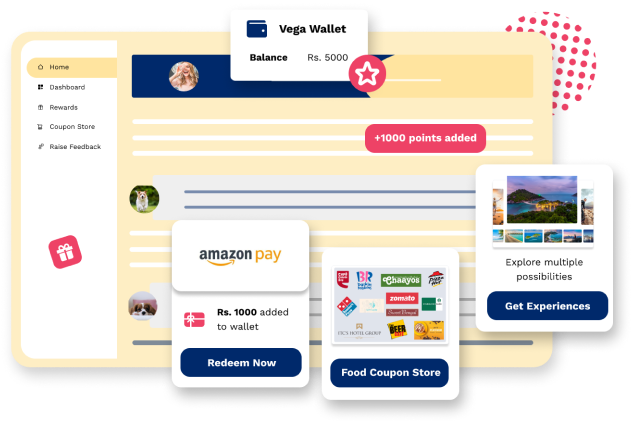Introduction
“Are you satisfied with your food?” - one of the most common questions you are faced with today. These are a form of surveys that organizations use to take feedback from customers. Similarly, companies can use surveys to understand the pulse and the employees' experience.
What is an Employee Experience Survey?
Employee experience surveys are a way for companies to gather feedback from their employees about their various aspects that affect the work culture of the organization. These surveys can cover a variety of topics such as communication, management, career development, and company culture. In fact, according to a study by SHRM, 70% of organizations surveyed said they conduct employee engagement surveys.
Employee experience surveys can be conducted in various ways, such as online surveys or through in-person interviews. These surveys can provide valuable insights into the strengths and weaknesses of an organization's culture and work environment. According to a survey by Deloitte, companies with high employee engagement are 87% more likely to have satisfied customers. Additionally, a study by Gallup found that companies with engaged employees outperform those without by 202%.
Advantages of an Employee Experience Survey
Employee experience surveys can provide valuable insights for organizations to better understand their employees' perspectives and identify areas for improvement. By measuring various aspects of the employee experience, such as job satisfaction, work environment, and communication, companies can take data-driven actions to create a more positive and engaging workplace.
Improved Employee Engagement: Conducting employee experience surveys helps companies identify areas where their employees may be disengaged or dissatisfied. This allows them to take targeted actions to address these issues, ultimately leading to higher levels of employee engagement. A study by Gallup found that highly engaged teams show 21% greater profitability.
Better Retention Rates: When employees feel that their opinions are heard and acted upon, they are more likely to stay with the company. Employee experience surveys can help companies understand what motivates their employees and what factors contribute to their job satisfaction, leading to better retention rates.
Increased Productivity: Satisfied and engaged employees tend to be more productive, leading to better business results. Employee experience surveys can help identify obstacles to productivity and provide insights into how to overcome them.
Improved Customer Satisfaction: Employee experience surveys can also help companies identify areas where employees may need additional training or support, ultimately leading to better customer satisfaction.
Better decision-making: Employee experience surveys provide companies with data-driven insights into their workforce, enabling them to make more informed decisions. These insights can help companies better understand employee motivations, strengths, and weaknesses, allowing them to make decisions that benefit both employees and the company. According to a study by McKinsey, companies that use people analytics to inform business decisions are 2.6 times more likely to be in the top quartile of financial performance within their industry.

Things to keep in mind while conducting Surveys
Here are some considerations to keep in mind while conducting employee experience surveys:
Anonymity and Confidentiality: Make sure your employees feel safe and comfortable providing honest feedback. Use anonymous surveys and avoid asking for personal identifying information.
Clarity of Questions: Ensure that your survey questions are easy to understand, concise, and not too complex.
Avoid Leading Questions: Questions that lead to a certain answer can skew the results of the survey. Be neutral and avoid any bias.
Frequency of Surveys: Decide on a reasonable frequency for conducting surveys, so employees are not overwhelmed with too many surveys or left feeling ignored.
Use Benchmarking: Compare your survey results to industry benchmarks or your own past results to get a better understanding of how you're doing.
Timely Communication: Keep employees informed about survey results and what actions will be taken based on the feedback.
Take Action: Address any issues highlighted by the survey results and provide regular updates on what changes have been made.
Different Types of Employee Surveys
What are the different objectives you can use employee survey questions for? Here are a few types of survey questions to help you start off -
Job Satisfaction Questions: These questions aim to measure how satisfied employees are with their job, work environment, workload, and other factors related to their job.
Leadership questions: These questions aim to measure how employees view their managers and supervisors, including their effectiveness, communication skills, and ability to lead and motivate.
Communication Questions: These questions aim to measure how employees feel about the organization's communication channels, including how often they receive information and how clear and transparent the communication is.
Engagement Questions: These questions aim to measure how engaged employees are with their work, including their motivation, commitment, and passion for their job.
Work-life Balance Questions: These questions aim to measure how employees balance their work and personal life, including the flexibility of their work schedule and the availability of benefits such as paid time off.
Career Development Questions: These questions aim to measure how employees view their opportunities for career growth and development within the organization.
Diversity and Inclusion Questions: These questions aim to measure how employees perceive the organization's commitment to diversity and inclusion, including whether they feel valued and respected at work.
Top 15 Employee Experience Survey Questions
The key to creating an effective employee experience survey is to ask the right questions. Asking relevant and insightful questions can provide valuable insights into employees' experiences. Let’s explore 15 of the top employee survey questions that can help you gather the feedback you need to improve your organization's employee experience.
Job Satisfaction:
- How satisfied are you with your job overall?
- How satisfied are you with your immediate supervisor's performance?
- How satisfied are you with your opportunities for career development?
- How satisfied are you with the benefits offered by the company?
- How satisfied are you with the level of feedback you receive about your job performance?
- How likely are you to recommend the company as a good workplace?
Communication and Transparency:
- How would you rate the clarity of your job responsibilities and expectations?
- How well does the company communicate its goals and objectives to employees?
- How well does the company foster a diverse and inclusive workplace?
- How satisfied are you with the level of trust and transparency between employees and management?
Work Environment:
- How often do you receive recognition or praise for your work?
- How would you rate the work-life balance at the company?
- How satisfied are you with the level of collaboration and teamwork within your department?
- How well does the company handle conflicts and interpersonal issues within the workplace?
- How satisfied are you with the company's training and development programs?
KPIs for Employee Surveys
KPIs for employee surveys are the metrics used to measure the effectiveness and success of an employee survey. They help to evaluate the areas where the organization is doing well and where improvements are required. Simply put, KPIs are the performance indicators that can help organizations to identify the strengths and weaknesses of their employee survey programs. By tracking and analyzing these KPIs, organizations can make data-driven decisions to improve the employee experience and increase employee engagement KPIs.
Here are some common KPIs for employee surveys:
Response Rate: This measures the percentage of employees who completed the survey. A higher response rate generally indicates higher engagement among employees.
Participation Rate: This KPI measures the percentage of employees who were invited to take the survey and actually completed it. This metric can help identify potential biases in the survey results.
Overall Satisfaction: This KPI measures how satisfied employees are with various aspects of their work, such as compensation, benefits, and company culture.
Net Promoter Score (NPS): This is a measure of how likely employees are to recommend their employer to others. It's based on a scale of 0 to 10 and is used to gauge overall employee loyalty.
Employee Engagement: This measures the emotional connection that employees have with their work and the company. Higher engagement levels have been linked to lower turnover rates and increased productivity.
Action Plan Completion: This KPI tracks how well the organization is implementing action plans based on the survey results. It measures the percentage of planned actions that have been completed.
Conclusion
Providing a positive employee experience is crucial for any organization looking to attract and retain top talent. Employee experience surveys are an effective tool to measure and improve the overall experience of employees in the workplace. In conclusion, the employee experience surveys can help organizations understand their employees' needs and expectations, identify areas for improvement, and take necessary action to enhance the overall employee experience
Furthermore, tracking key performance indicators can help organizations measure the effectiveness of their surveys and make necessary improvements. Ultimately, by using these tips and questions, organizations can create a positive work culture. All in all, employee surveys can give us very important insights into employees’ experience and where we can improve it.
Frequently asked questions
About Vega HR
Vega-HR is a powerful tool in the talent war, offering employee rewards, recognition, and pulse recognition. With an engaging platform, it fosters a world-class work culture, providing P2P recognition, social feedback, on-spot recognition, and monetizable incentive solutions with 3000+ coupons in various categories.
Create a Culture People Want to Stick to
- Send rewards
- Give shoutouts
- Build a community
- Gift experiences
Get a demo
 Written by Varshith Mittapalli 21 April 2023 | 4 min read
Written by Varshith Mittapalli 21 April 2023 | 4 min read





